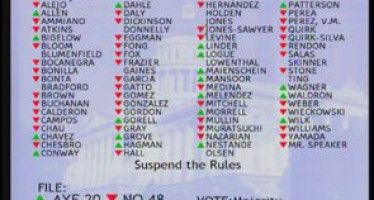Voting Out the Electoral College
Creating over-reaching solutions for non-existent problems is what California legislators are good at. A textbook example of this is a bill awaiting Gov. Jerry Brown’s signature which would change the state’s Electoral College process.
AB 459 passed in the Legislature in July without any Republican votes. It would provide a boost to the National Popular Vote Interstate Compact movement.
NPV has been pushing states since 2000 to replace the Electoral College system. That was the year of the controversial victory of George W. Bush over Al Gore. Gore won the popular vote nationally. But he lost the vote in the electoral college because, after a recount in Florida, Bush won that state’s electoral votes — and more electoral votes nationally.
NPV awards a state’s electoral votes to the national winner of the popular vote, regardless of which candidate won in that state. Thus, John Doe might lose in California by 1 million votes. But if he won nationally by 1,000 votes, under NPV he would get California’s 55 electoral votes anyway in the Electoral College.
Supporters of AB 459 insist that the change would require candidates to actually campaign in all states, not just in swing states. California especially would be affected because Democrats have won landslides in recent elections here; President Obama won in 2008 by more than 3 million votes. That means candidates of both parties don’t waste time campaigning here except to troll for contributors’ cash.
Junking the Electoral College
Opponents say the real goal is to eventually eliminate the Electoral College altogether. Once Americans are used to thinking of the election more as a vast popular vote, then the National Popular Vote Compact itself would be displaced in favor a constitutional amendment junking the Electoral College entirely in favor of a pure popular vote.
Under NPV, presidential candidates would look only at the large population areas in the country for votes: New York, Los Angeles, Dallas, Chicago and San Francisco. Rural states, such as Wyoming and North Dakota, would be ignored. The federalist nature of the country, which consists of “free and independent states,” would be fatally compromised.
The U.S. Constitution was written to allow states to have the authority to decide how their electors are selected. Most states use a “winner-take-all” system, where the presidential candidate who wins the majority of the popular vote in the state gets all of its electors.
The 538 members of the Electoral College elect the president. Each state gets one “elector” for every representative it has in Congress. California has 55 electors — the most of any state.
The National Popular Vote bill in California was originally touted to be a bipartisan effort authored by Republican Assemblyman Brian Nestande of Palm Desert and Democratic Assemblyman Jerry Hill of San Mateo. Several Republicans had signed on to the cause. AB 459 was amended several times, adding Democratic legislators as supporters. Eventually the names of Nestande and other Republicans who had signed on were removed.
The bill commits California to a compact in which the state would have to agree to give its Electoral College votes to the presidential candidate who wins the most popular votes nationally. According to the bill’s author, this is because, “California is ignored in the general elections of Presidential campaigns. Candidates do not visit our state, they do not advertise here, poll here, conduct field operations, send mail, or engage in any of the other normal campaign activities. The one exception is that they do fundraise in California ($150 million collected in 2008). However, once the money is collected, it is spent almost completely outside our borders.”
Currently seven states, plus the District of Columbia, have passed the law; they total 77 Electoral College seats. If AB 459 is signed by Brown, the National Popular Vote movement will have achieved 132 electoral votes. NPV wouild go into effect only if enough states pass it that 270 or more electoral votes would be affected by it. The 270 votes would be a majority of the Electoral College.
Constitutional Questions
But many in the state say that no repair is needed because the system is not broken. Critics say that the popular vote scheme raises both practical and constitutional questions.
Proponents say that every vote in every state will matter in every presidential election.
Critics don’t just disagree. They warn that it is a dangerous end run around amending the Constitution. “NPV brings about this change without amending the Constitution, thereby undermining the legitimacy of presidential elections,” according to the CATO Institute. “It also weakens federalism by eliminating the role of the states in presidential contests.”
NPV has been ratified by Hawaii, Illinois, Massachusetts, Maryland, New Jersey, Vermont, Washington and the District of Columbia. Starting with the 2012 presidential election, those states and the District of Columbia collectively will have 74 electoral votes.
Supporting the reform, the League of Women Voters said that many politicians worry there is a perception that it will disenfranchise a significant portion of their own state constituencies. And many governors and state senators have been reluctant to outwardly embrace the change.
More Division?
“The NPV movement is still using the Electoral College to get around the Electoral College,” said Mark Standriff, communications director for the California Republican Party.
“This effort will result in an even more divided America,” California Republican Party Chairman Tom Del Beccaro recently wrote in an opinion editorial. “The further balkanization of America is a bad idea and one major reason the Electoral College exists. Our Founders wanted to give Delaware a chance against Virginia.”
Some Republicans support NPV. “Candidates would have to go where the people are,” said former Republican state Sen. Jim Brulte, now a political consultant. “They’d essentially have to campaign everywhere, because they couldn’t afford to neglect areas where a little effort might turn out a larger vote. Under NPV, they would have to spend less money in states like Florida and Ohio and more in California and Texas, because every additional vote they got out would count. As it stands now, an additional vote, or 100,000 votes, in those states doesn’t matter much at all.”
But that isn’t the view of most Republicans. “Our constitution has numerous checks on raw democracy, or majority tyranny, and the Electoral College is an important one,” said John Eastman, former dean of the Chapman University School of Law in a recent analysis for the California Republican Party. Eastman said that the the legal analysis is “surprisingly weak” surrounding the issues of the National Popular Vote movement.
Brown is expected to sign AB 459.
Read CalWatchdog’s May story, “California Could Kill Electoral College“
Related Articles
More food stamp cuts coming
Last week, expansions ended to the Supplemental Nutrition Assistance Program (SNAP), better known as the Food Stamp program. Food stamp
L.A. gets Rams, maybe Chargers
After a frenetic final sequence where NFL intrigue reached a fever pitch, team owners voted to approve the relocation of
Dems water down GOP pro-small biz bill
June 10, 2013 By Katy Grimes SACRAMENTO — A bill “bait and switch” reveals a lot about attitudes toward small





